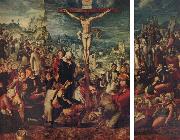
Oil On
Canvas, Real Flavor of Old Masters
|
Legros, Alphonse
|
|||
|
|
|||
| French-born British Painter and Sculptor, 1837-1911 British etcher, painter, sculptor and teacher of French birth. He is said to have been apprenticed at the age of 11 to a sign-painter, at which time he may also have attended classes at the Ecole des Beaux-Arts in Dijon. He was employed as assistant on a decorative scheme in Lyon Cathedral before moving in 1851 to Paris, where he worked initially for the theatre decorator C. A. Cambon (1802-75). He soon became a pupil of Horace Lecoq de Boisbaudran, whose methodical instruction and liberality in fostering individual talent proved of lasting benefit to Legros. In 1855 he enrolled at the Ecole des Beaux-Arts, Paris, attending irregularly until 1857. During this period Legros had a taste for early Netherlandish art and for French Romanticism, which was later superseded by his admiration for Claude, Poussin and Michelangelo. | |||
|
|
|||
|
|
Calvary new5/Legros, Alphonse_6hF8TP.jpg Painting ID:: 19144 Visit European Gallery |
1874, Mus??e d'Orsay, Paris | |
Height Width |
INS/CM |
||
|
X |
|
||
|
|
|||
|
James Ensor
|
|||
|
|
|||
| Belgian 1860-1949 Belgian painter, printmaker and draughtsman. No single label adequately describes the visionary work produced by Ensor between 1880 and 1900, his most productive period. His pictures from that time have both Symbolist and Realist aspects, and in spite of his dismissal of the Impressionists as superficial daubers he was profoundly concerned with the effects of light. His imagery and technical procedures anticipated the colouristic brilliance and violent impact of Fauvism and German Expressionism and the psychological fantasies of Surrealism. Ensor most memorable and influential work was almost exclusively produced before 1900, but he was largely unrecognized before the 1920s in his own country. His work was highly influential in Germany, however: Emil Nolde visited him in 1911, and was influenced by his use of masks; Paul Klee mentions him admiringly in his diaries; Erich Heckel came to see him in the middle of the war and painted his portrait (1930; Cologne, Wallraf-Richartz-Mus.); Alfred Kubin owned several of his prints, while Marc Chagall and George Grosz also adapted certain elements from Ensor. All the artists of the Cobra group saw him as a master. He influenced many Belgian artists including Leon Spilliaert, Rik Wouters, Constant Permeke, Frits van den Berghe, Paul Delvaux and Pierre Alechinsky. | |||
|
|
|||
|
|
Calvary new11/James Ensor-343326.jpg Painting ID:: 37457 Visit European Gallery |
mk126 1880-86 | |
Height Width |
INS/CM |
||
|
X |
|
||
|
|
|||
|
The Brunswick Monogrammist
|
|||
|
|
|||
| active in Antwerp 1588 - 1629 | |||
|
|
|||
|
|
Calvary new16/The Brunswick Monogrammist-288578.jpg Painting ID:: 40989 Visit European Gallery |
mk159 triptych mid-16th century Oil on panel central part 77x44.5cm | |
Height Width |
INS/CM |
||
|
X |
|
||
|
|
|||
|
unknow artist
|
|||
|
|
|||
|
|
|||
|
|
Calvary new21/unknow artist-939286.jpg Painting ID:: 63983 Visit European Gallery |
1500 Oil on oak panel, 142 x 225,5 cm Groeninge Museum, Bruges Borrowings from a variety of artists (Master of Flemalle, Van der Goes, Memling and Derer) are found in the Crucifixion, most likely painted in 1500. (The date on the original frame could be rewritten.) The anonymous Bruges master, referred to on the basis of this work as the 'Master of the Bruges Passion Scenes', combined the three principal elements of the Passion story in a single landscape setting. , Artist: UNKNOWN MASTER, Flemish , Calvary , 1501-1550 , Flemish , painting , religious | |
Height Width |
INS/CM |
||
|
X |
|
||
|
|
|||










